Project Analysis: Solving Design Challenges in Aircraft Landing Gears
VerifiedAdded on 2023/06/13
|9
|2162
|60
Project
AI Summary
This project analysis delves into the multifaceted challenges encountered during the design and development of aircraft landing gears. It identifies key issues such as inappropriate question during interviews, inconsistency between interviewer and respondent, interview fatigue, and dishonesty during data collection, offering solutions like structured interview approaches and direct questioning. The analysis extends to experimentation challenges, including incomplete procedures, limited data scope, and component acquisition difficulties. Furthermore, the project addresses inappropriate technology use, landing gear load considerations, and material selection challenges, proposing advanced technologies and analysis methods to meet safety and regulatory requirements. The study also explores the merits and demerits of various landing gear arrangements, such as Tricycle-Type, Tandem, and Tail Wheel-Type, providing insights for designers to make informed decisions. The analysis emphasizes the importance of shock absorption and feasibility studies in the design process. This document is available on Desklib, which provides a platform for students to access a wealth of study resources, including past papers and solved assignments.

PROJECT ANALYSIS 1
PROJECT ANALYSIS
By Name
Course
Instructor
Institution
Location
Date
PROJECT ANALYSIS
By Name
Course
Instructor
Institution
Location
Date
Paraphrase This Document
Need a fresh take? Get an instant paraphrase of this document with our AI Paraphraser
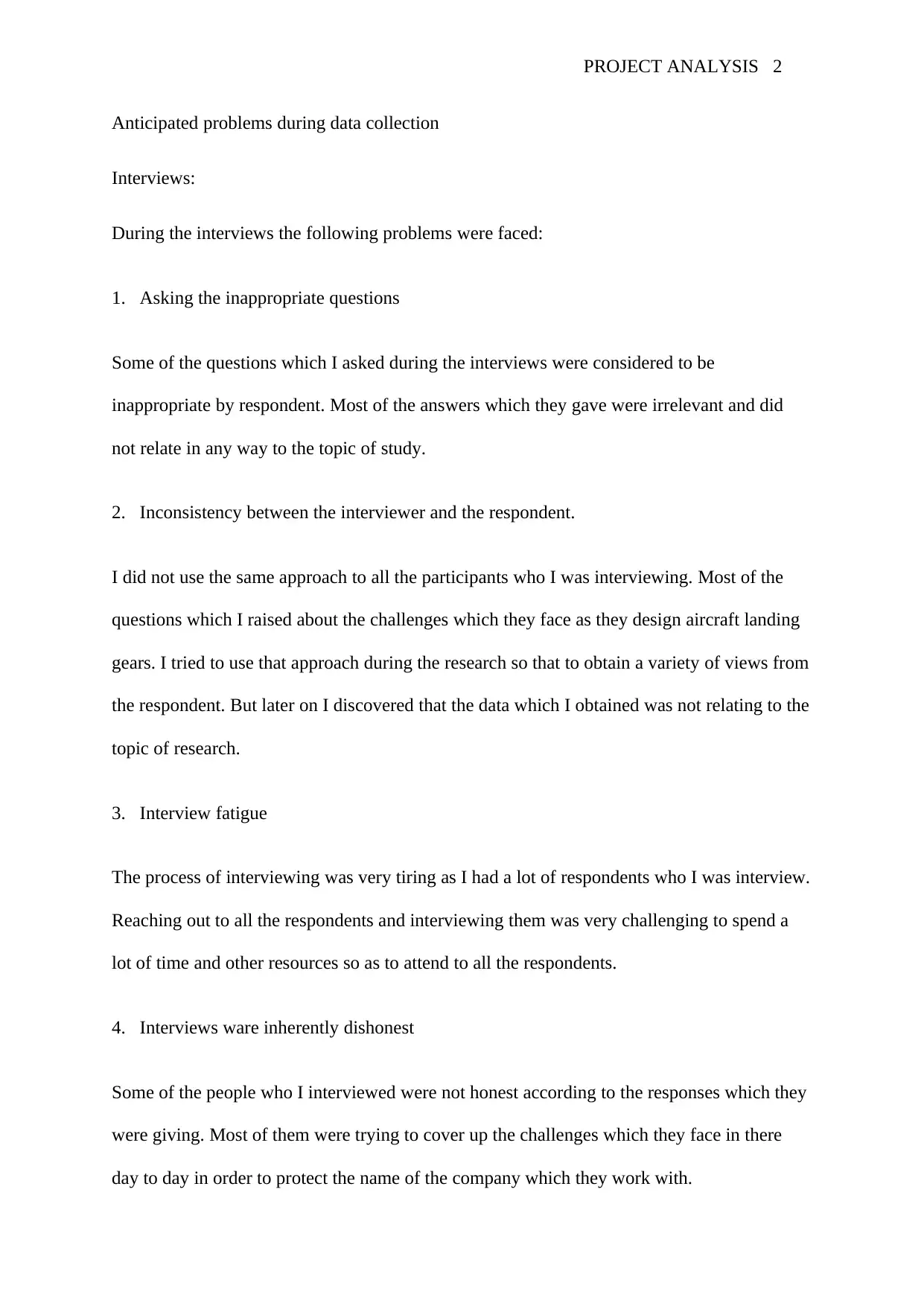
PROJECT ANALYSIS 2
Anticipated problems during data collection
Interviews:
During the interviews the following problems were faced:
1. Asking the inappropriate questions
Some of the questions which I asked during the interviews were considered to be
inappropriate by respondent. Most of the answers which they gave were irrelevant and did
not relate in any way to the topic of study.
2. Inconsistency between the interviewer and the respondent.
I did not use the same approach to all the participants who I was interviewing. Most of the
questions which I raised about the challenges which they face as they design aircraft landing
gears. I tried to use that approach during the research so that to obtain a variety of views from
the respondent. But later on I discovered that the data which I obtained was not relating to the
topic of research.
3. Interview fatigue
The process of interviewing was very tiring as I had a lot of respondents who I was interview.
Reaching out to all the respondents and interviewing them was very challenging to spend a
lot of time and other resources so as to attend to all the respondents.
4. Interviews ware inherently dishonest
Some of the people who I interviewed were not honest according to the responses which they
were giving. Most of them were trying to cover up the challenges which they face in there
day to day in order to protect the name of the company which they work with.
Anticipated problems during data collection
Interviews:
During the interviews the following problems were faced:
1. Asking the inappropriate questions
Some of the questions which I asked during the interviews were considered to be
inappropriate by respondent. Most of the answers which they gave were irrelevant and did
not relate in any way to the topic of study.
2. Inconsistency between the interviewer and the respondent.
I did not use the same approach to all the participants who I was interviewing. Most of the
questions which I raised about the challenges which they face as they design aircraft landing
gears. I tried to use that approach during the research so that to obtain a variety of views from
the respondent. But later on I discovered that the data which I obtained was not relating to the
topic of research.
3. Interview fatigue
The process of interviewing was very tiring as I had a lot of respondents who I was interview.
Reaching out to all the respondents and interviewing them was very challenging to spend a
lot of time and other resources so as to attend to all the respondents.
4. Interviews ware inherently dishonest
Some of the people who I interviewed were not honest according to the responses which they
were giving. Most of them were trying to cover up the challenges which they face in there
day to day in order to protect the name of the company which they work with.
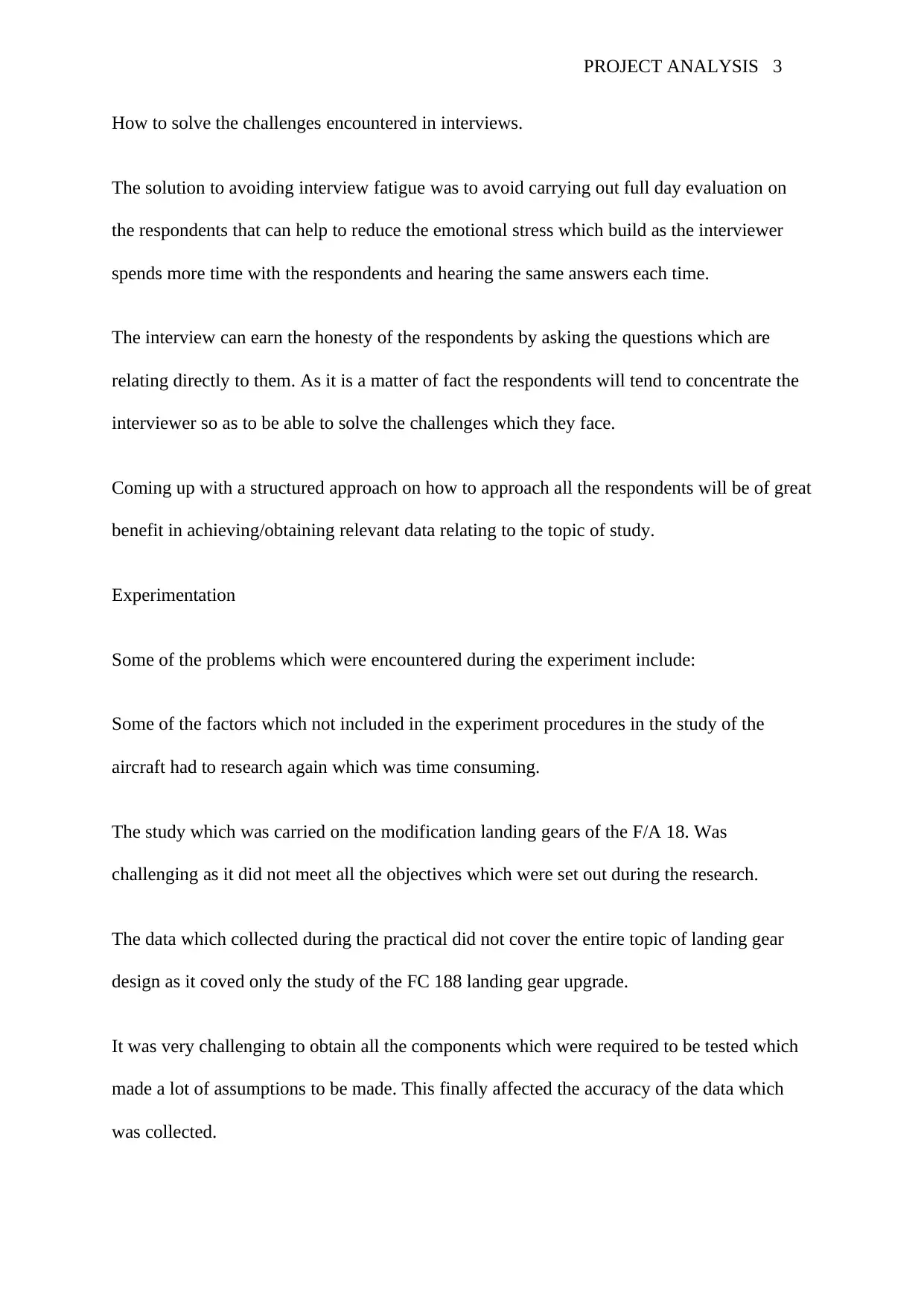
PROJECT ANALYSIS 3
How to solve the challenges encountered in interviews.
The solution to avoiding interview fatigue was to avoid carrying out full day evaluation on
the respondents that can help to reduce the emotional stress which build as the interviewer
spends more time with the respondents and hearing the same answers each time.
The interview can earn the honesty of the respondents by asking the questions which are
relating directly to them. As it is a matter of fact the respondents will tend to concentrate the
interviewer so as to be able to solve the challenges which they face.
Coming up with a structured approach on how to approach all the respondents will be of great
benefit in achieving/obtaining relevant data relating to the topic of study.
Experimentation
Some of the problems which were encountered during the experiment include:
Some of the factors which not included in the experiment procedures in the study of the
aircraft had to research again which was time consuming.
The study which was carried on the modification landing gears of the F/A 18. Was
challenging as it did not meet all the objectives which were set out during the research.
The data which collected during the practical did not cover the entire topic of landing gear
design as it coved only the study of the FC 188 landing gear upgrade.
It was very challenging to obtain all the components which were required to be tested which
made a lot of assumptions to be made. This finally affected the accuracy of the data which
was collected.
How to solve the challenges encountered in interviews.
The solution to avoiding interview fatigue was to avoid carrying out full day evaluation on
the respondents that can help to reduce the emotional stress which build as the interviewer
spends more time with the respondents and hearing the same answers each time.
The interview can earn the honesty of the respondents by asking the questions which are
relating directly to them. As it is a matter of fact the respondents will tend to concentrate the
interviewer so as to be able to solve the challenges which they face.
Coming up with a structured approach on how to approach all the respondents will be of great
benefit in achieving/obtaining relevant data relating to the topic of study.
Experimentation
Some of the problems which were encountered during the experiment include:
Some of the factors which not included in the experiment procedures in the study of the
aircraft had to research again which was time consuming.
The study which was carried on the modification landing gears of the F/A 18. Was
challenging as it did not meet all the objectives which were set out during the research.
The data which collected during the practical did not cover the entire topic of landing gear
design as it coved only the study of the FC 188 landing gear upgrade.
It was very challenging to obtain all the components which were required to be tested which
made a lot of assumptions to be made. This finally affected the accuracy of the data which
was collected.
⊘ This is a preview!⊘
Do you want full access?
Subscribe today to unlock all pages.

Trusted by 1+ million students worldwide
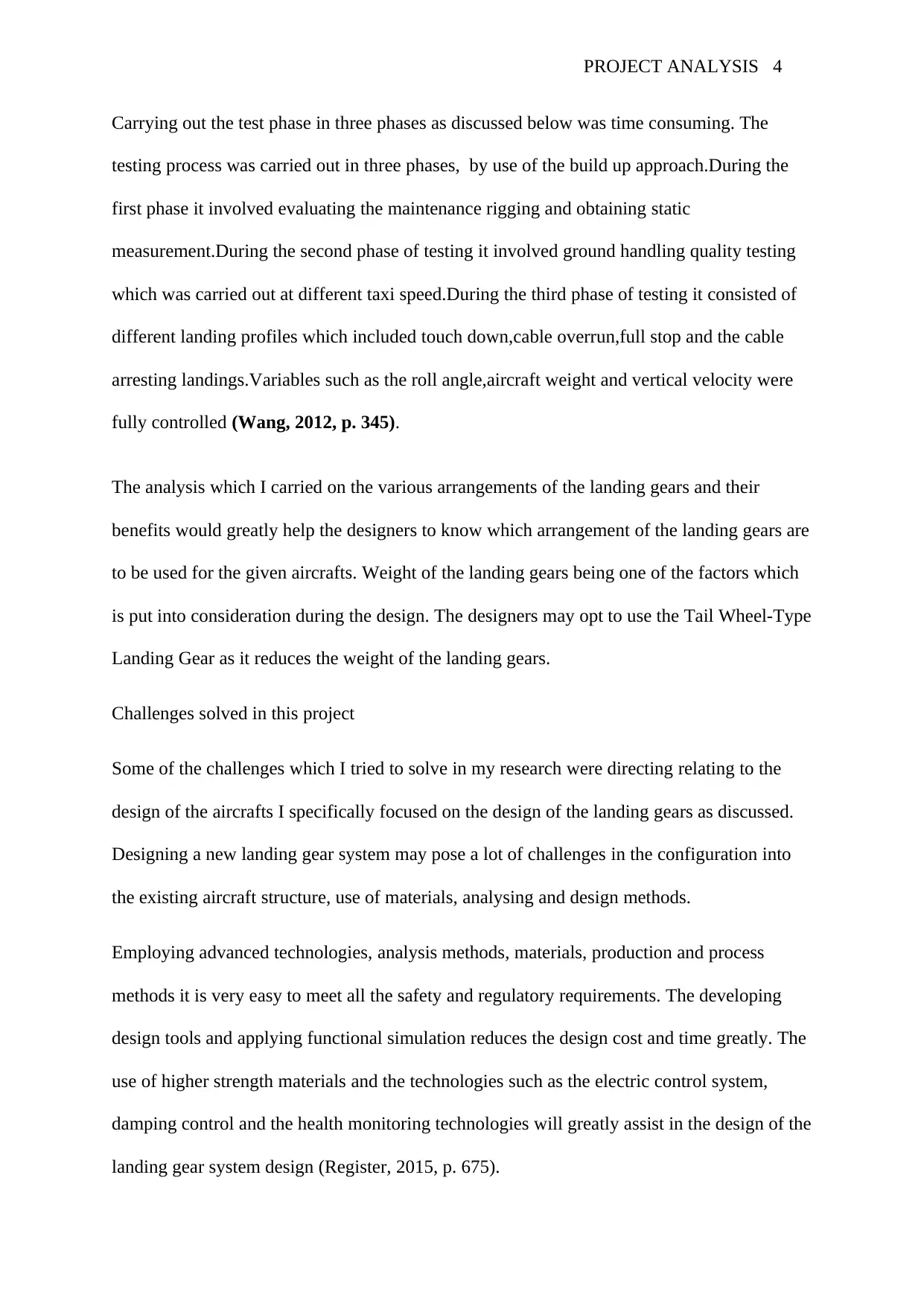
PROJECT ANALYSIS 4
Carrying out the test phase in three phases as discussed below was time consuming. The
testing process was carried out in three phases, by use of the build up approach.During the
first phase it involved evaluating the maintenance rigging and obtaining static
measurement.During the second phase of testing it involved ground handling quality testing
which was carried out at different taxi speed.During the third phase of testing it consisted of
different landing profiles which included touch down,cable overrun,full stop and the cable
arresting landings.Variables such as the roll angle,aircraft weight and vertical velocity were
fully controlled (Wang, 2012, p. 345).
The analysis which I carried on the various arrangements of the landing gears and their
benefits would greatly help the designers to know which arrangement of the landing gears are
to be used for the given aircrafts. Weight of the landing gears being one of the factors which
is put into consideration during the design. The designers may opt to use the Tail Wheel-Type
Landing Gear as it reduces the weight of the landing gears.
Challenges solved in this project
Some of the challenges which I tried to solve in my research were directing relating to the
design of the aircrafts I specifically focused on the design of the landing gears as discussed.
Designing a new landing gear system may pose a lot of challenges in the configuration into
the existing aircraft structure, use of materials, analysing and design methods.
Employing advanced technologies, analysis methods, materials, production and process
methods it is very easy to meet all the safety and regulatory requirements. The developing
design tools and applying functional simulation reduces the design cost and time greatly. The
use of higher strength materials and the technologies such as the electric control system,
damping control and the health monitoring technologies will greatly assist in the design of the
landing gear system design (Register, 2015, p. 675).
Carrying out the test phase in three phases as discussed below was time consuming. The
testing process was carried out in three phases, by use of the build up approach.During the
first phase it involved evaluating the maintenance rigging and obtaining static
measurement.During the second phase of testing it involved ground handling quality testing
which was carried out at different taxi speed.During the third phase of testing it consisted of
different landing profiles which included touch down,cable overrun,full stop and the cable
arresting landings.Variables such as the roll angle,aircraft weight and vertical velocity were
fully controlled (Wang, 2012, p. 345).
The analysis which I carried on the various arrangements of the landing gears and their
benefits would greatly help the designers to know which arrangement of the landing gears are
to be used for the given aircrafts. Weight of the landing gears being one of the factors which
is put into consideration during the design. The designers may opt to use the Tail Wheel-Type
Landing Gear as it reduces the weight of the landing gears.
Challenges solved in this project
Some of the challenges which I tried to solve in my research were directing relating to the
design of the aircrafts I specifically focused on the design of the landing gears as discussed.
Designing a new landing gear system may pose a lot of challenges in the configuration into
the existing aircraft structure, use of materials, analysing and design methods.
Employing advanced technologies, analysis methods, materials, production and process
methods it is very easy to meet all the safety and regulatory requirements. The developing
design tools and applying functional simulation reduces the design cost and time greatly. The
use of higher strength materials and the technologies such as the electric control system,
damping control and the health monitoring technologies will greatly assist in the design of the
landing gear system design (Register, 2015, p. 675).
Paraphrase This Document
Need a fresh take? Get an instant paraphrase of this document with our AI Paraphraser
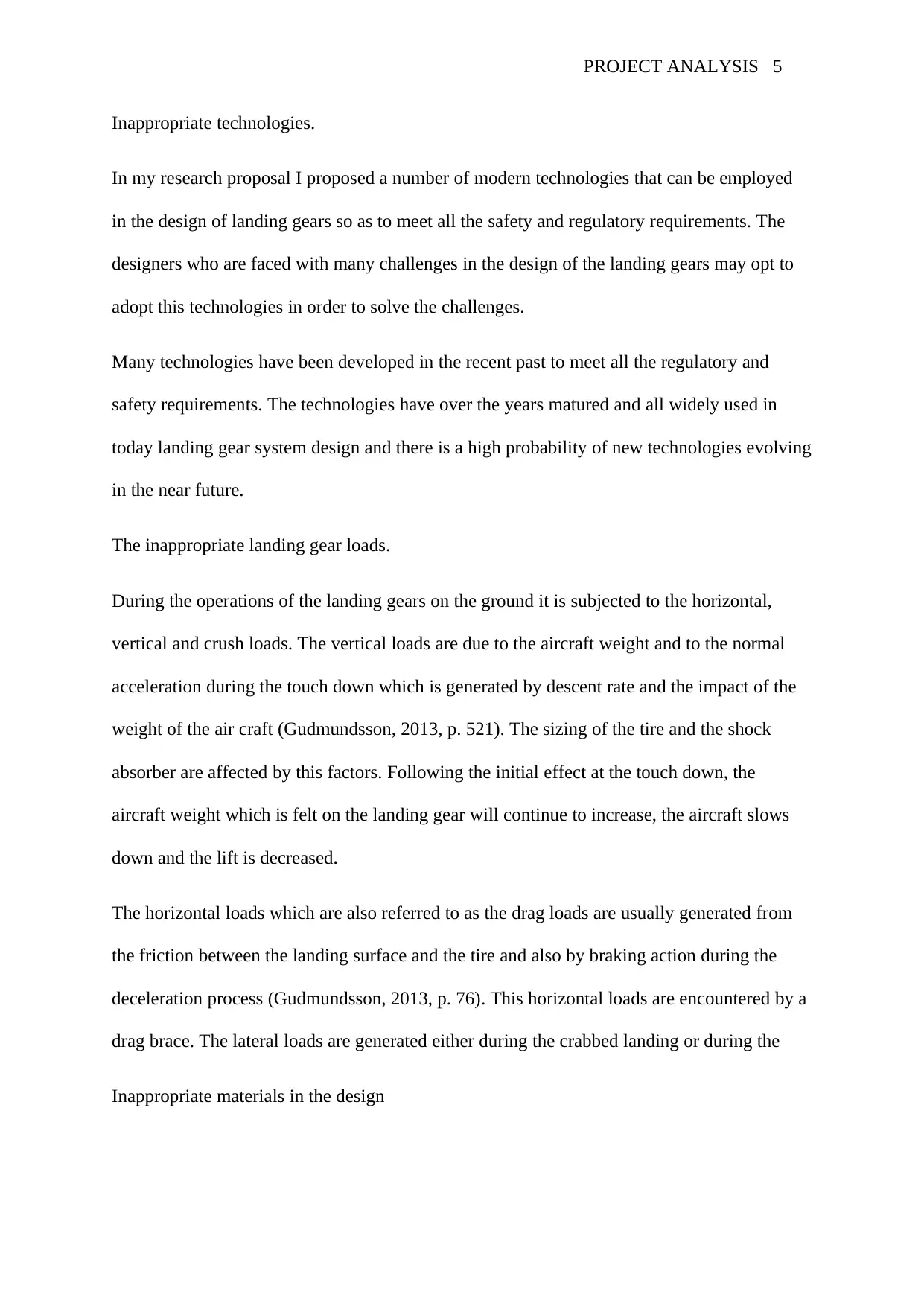
PROJECT ANALYSIS 5
Inappropriate technologies.
In my research proposal I proposed a number of modern technologies that can be employed
in the design of landing gears so as to meet all the safety and regulatory requirements. The
designers who are faced with many challenges in the design of the landing gears may opt to
adopt this technologies in order to solve the challenges.
Many technologies have been developed in the recent past to meet all the regulatory and
safety requirements. The technologies have over the years matured and all widely used in
today landing gear system design and there is a high probability of new technologies evolving
in the near future.
The inappropriate landing gear loads.
During the operations of the landing gears on the ground it is subjected to the horizontal,
vertical and crush loads. The vertical loads are due to the aircraft weight and to the normal
acceleration during the touch down which is generated by descent rate and the impact of the
weight of the air craft (Gudmundsson, 2013, p. 521). The sizing of the tire and the shock
absorber are affected by this factors. Following the initial effect at the touch down, the
aircraft weight which is felt on the landing gear will continue to increase, the aircraft slows
down and the lift is decreased.
The horizontal loads which are also referred to as the drag loads are usually generated from
the friction between the landing surface and the tire and also by braking action during the
deceleration process (Gudmundsson, 2013, p. 76). This horizontal loads are encountered by a
drag brace. The lateral loads are generated either during the crabbed landing or during the
Inappropriate materials in the design
Inappropriate technologies.
In my research proposal I proposed a number of modern technologies that can be employed
in the design of landing gears so as to meet all the safety and regulatory requirements. The
designers who are faced with many challenges in the design of the landing gears may opt to
adopt this technologies in order to solve the challenges.
Many technologies have been developed in the recent past to meet all the regulatory and
safety requirements. The technologies have over the years matured and all widely used in
today landing gear system design and there is a high probability of new technologies evolving
in the near future.
The inappropriate landing gear loads.
During the operations of the landing gears on the ground it is subjected to the horizontal,
vertical and crush loads. The vertical loads are due to the aircraft weight and to the normal
acceleration during the touch down which is generated by descent rate and the impact of the
weight of the air craft (Gudmundsson, 2013, p. 521). The sizing of the tire and the shock
absorber are affected by this factors. Following the initial effect at the touch down, the
aircraft weight which is felt on the landing gear will continue to increase, the aircraft slows
down and the lift is decreased.
The horizontal loads which are also referred to as the drag loads are usually generated from
the friction between the landing surface and the tire and also by braking action during the
deceleration process (Gudmundsson, 2013, p. 76). This horizontal loads are encountered by a
drag brace. The lateral loads are generated either during the crabbed landing or during the
Inappropriate materials in the design
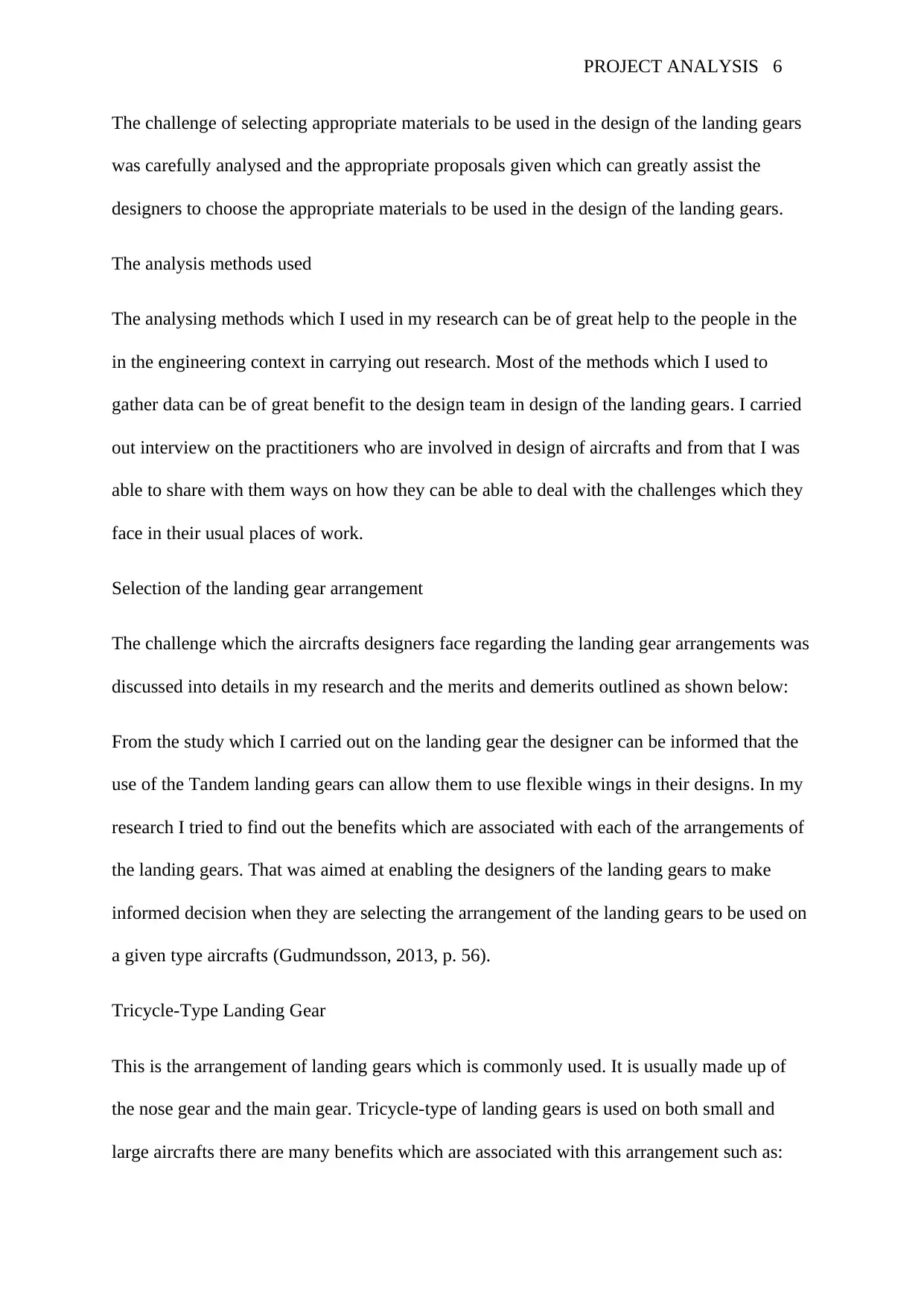
PROJECT ANALYSIS 6
The challenge of selecting appropriate materials to be used in the design of the landing gears
was carefully analysed and the appropriate proposals given which can greatly assist the
designers to choose the appropriate materials to be used in the design of the landing gears.
The analysis methods used
The analysing methods which I used in my research can be of great help to the people in the
in the engineering context in carrying out research. Most of the methods which I used to
gather data can be of great benefit to the design team in design of the landing gears. I carried
out interview on the practitioners who are involved in design of aircrafts and from that I was
able to share with them ways on how they can be able to deal with the challenges which they
face in their usual places of work.
Selection of the landing gear arrangement
The challenge which the aircrafts designers face regarding the landing gear arrangements was
discussed into details in my research and the merits and demerits outlined as shown below:
From the study which I carried out on the landing gear the designer can be informed that the
use of the Tandem landing gears can allow them to use flexible wings in their designs. In my
research I tried to find out the benefits which are associated with each of the arrangements of
the landing gears. That was aimed at enabling the designers of the landing gears to make
informed decision when they are selecting the arrangement of the landing gears to be used on
a given type aircrafts (Gudmundsson, 2013, p. 56).
Tricycle-Type Landing Gear
This is the arrangement of landing gears which is commonly used. It is usually made up of
the nose gear and the main gear. Tricycle-type of landing gears is used on both small and
large aircrafts there are many benefits which are associated with this arrangement such as:
The challenge of selecting appropriate materials to be used in the design of the landing gears
was carefully analysed and the appropriate proposals given which can greatly assist the
designers to choose the appropriate materials to be used in the design of the landing gears.
The analysis methods used
The analysing methods which I used in my research can be of great help to the people in the
in the engineering context in carrying out research. Most of the methods which I used to
gather data can be of great benefit to the design team in design of the landing gears. I carried
out interview on the practitioners who are involved in design of aircrafts and from that I was
able to share with them ways on how they can be able to deal with the challenges which they
face in their usual places of work.
Selection of the landing gear arrangement
The challenge which the aircrafts designers face regarding the landing gear arrangements was
discussed into details in my research and the merits and demerits outlined as shown below:
From the study which I carried out on the landing gear the designer can be informed that the
use of the Tandem landing gears can allow them to use flexible wings in their designs. In my
research I tried to find out the benefits which are associated with each of the arrangements of
the landing gears. That was aimed at enabling the designers of the landing gears to make
informed decision when they are selecting the arrangement of the landing gears to be used on
a given type aircrafts (Gudmundsson, 2013, p. 56).
Tricycle-Type Landing Gear
This is the arrangement of landing gears which is commonly used. It is usually made up of
the nose gear and the main gear. Tricycle-type of landing gears is used on both small and
large aircrafts there are many benefits which are associated with this arrangement such as:
⊘ This is a preview!⊘
Do you want full access?
Subscribe today to unlock all pages.

Trusted by 1+ million students worldwide
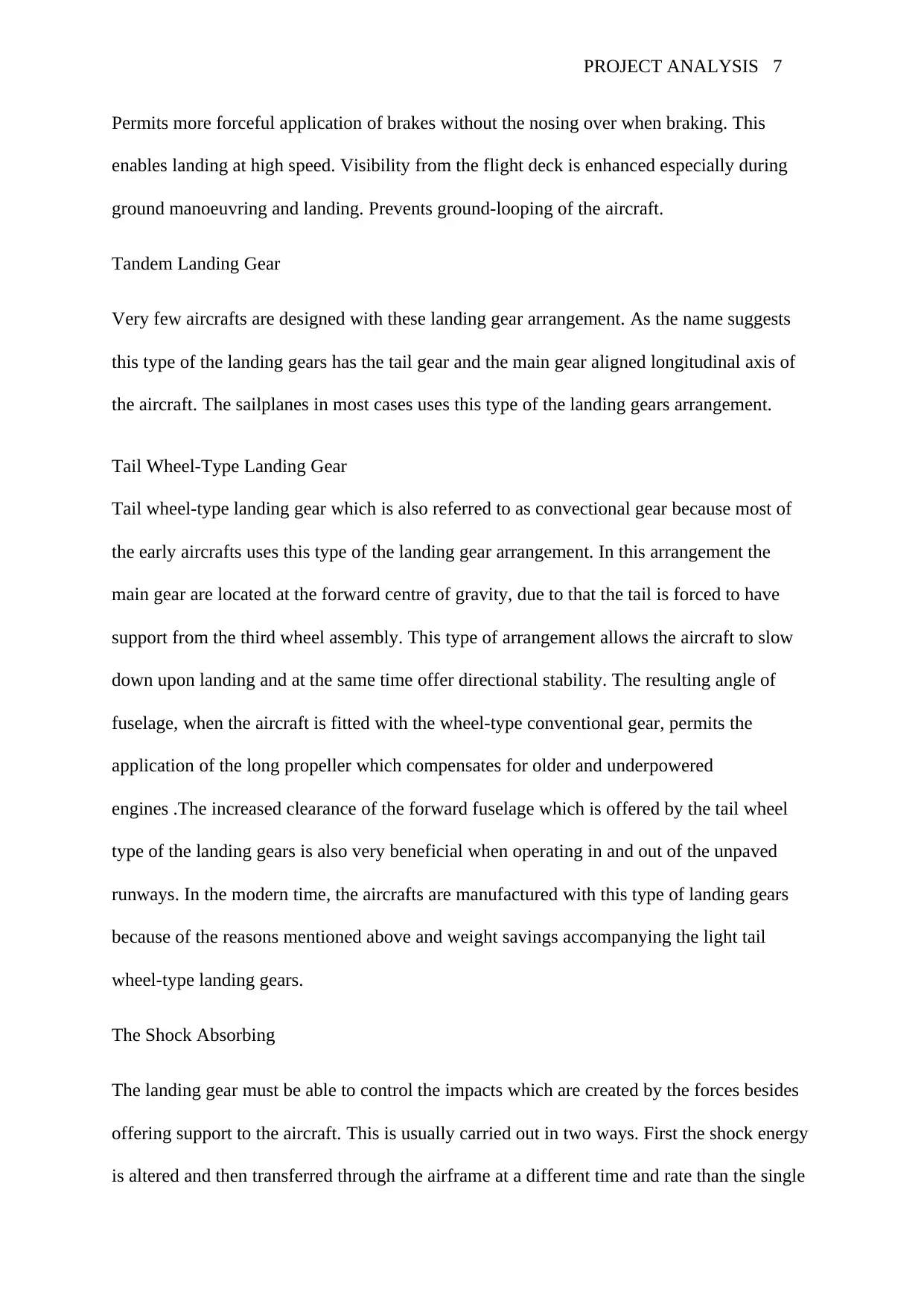
PROJECT ANALYSIS 7
Permits more forceful application of brakes without the nosing over when braking. This
enables landing at high speed. Visibility from the flight deck is enhanced especially during
ground manoeuvring and landing. Prevents ground-looping of the aircraft.
Tandem Landing Gear
Very few aircrafts are designed with these landing gear arrangement. As the name suggests
this type of the landing gears has the tail gear and the main gear aligned longitudinal axis of
the aircraft. The sailplanes in most cases uses this type of the landing gears arrangement.
Tail Wheel-Type Landing Gear
Tail wheel-type landing gear which is also referred to as convectional gear because most of
the early aircrafts uses this type of the landing gear arrangement. In this arrangement the
main gear are located at the forward centre of gravity, due to that the tail is forced to have
support from the third wheel assembly. This type of arrangement allows the aircraft to slow
down upon landing and at the same time offer directional stability. The resulting angle of
fuselage, when the aircraft is fitted with the wheel-type conventional gear, permits the
application of the long propeller which compensates for older and underpowered
engines .The increased clearance of the forward fuselage which is offered by the tail wheel
type of the landing gears is also very beneficial when operating in and out of the unpaved
runways. In the modern time, the aircrafts are manufactured with this type of landing gears
because of the reasons mentioned above and weight savings accompanying the light tail
wheel-type landing gears.
The Shock Absorbing
The landing gear must be able to control the impacts which are created by the forces besides
offering support to the aircraft. This is usually carried out in two ways. First the shock energy
is altered and then transferred through the airframe at a different time and rate than the single
Permits more forceful application of brakes without the nosing over when braking. This
enables landing at high speed. Visibility from the flight deck is enhanced especially during
ground manoeuvring and landing. Prevents ground-looping of the aircraft.
Tandem Landing Gear
Very few aircrafts are designed with these landing gear arrangement. As the name suggests
this type of the landing gears has the tail gear and the main gear aligned longitudinal axis of
the aircraft. The sailplanes in most cases uses this type of the landing gears arrangement.
Tail Wheel-Type Landing Gear
Tail wheel-type landing gear which is also referred to as convectional gear because most of
the early aircrafts uses this type of the landing gear arrangement. In this arrangement the
main gear are located at the forward centre of gravity, due to that the tail is forced to have
support from the third wheel assembly. This type of arrangement allows the aircraft to slow
down upon landing and at the same time offer directional stability. The resulting angle of
fuselage, when the aircraft is fitted with the wheel-type conventional gear, permits the
application of the long propeller which compensates for older and underpowered
engines .The increased clearance of the forward fuselage which is offered by the tail wheel
type of the landing gears is also very beneficial when operating in and out of the unpaved
runways. In the modern time, the aircrafts are manufactured with this type of landing gears
because of the reasons mentioned above and weight savings accompanying the light tail
wheel-type landing gears.
The Shock Absorbing
The landing gear must be able to control the impacts which are created by the forces besides
offering support to the aircraft. This is usually carried out in two ways. First the shock energy
is altered and then transferred through the airframe at a different time and rate than the single
Paraphrase This Document
Need a fresh take? Get an instant paraphrase of this document with our AI Paraphraser
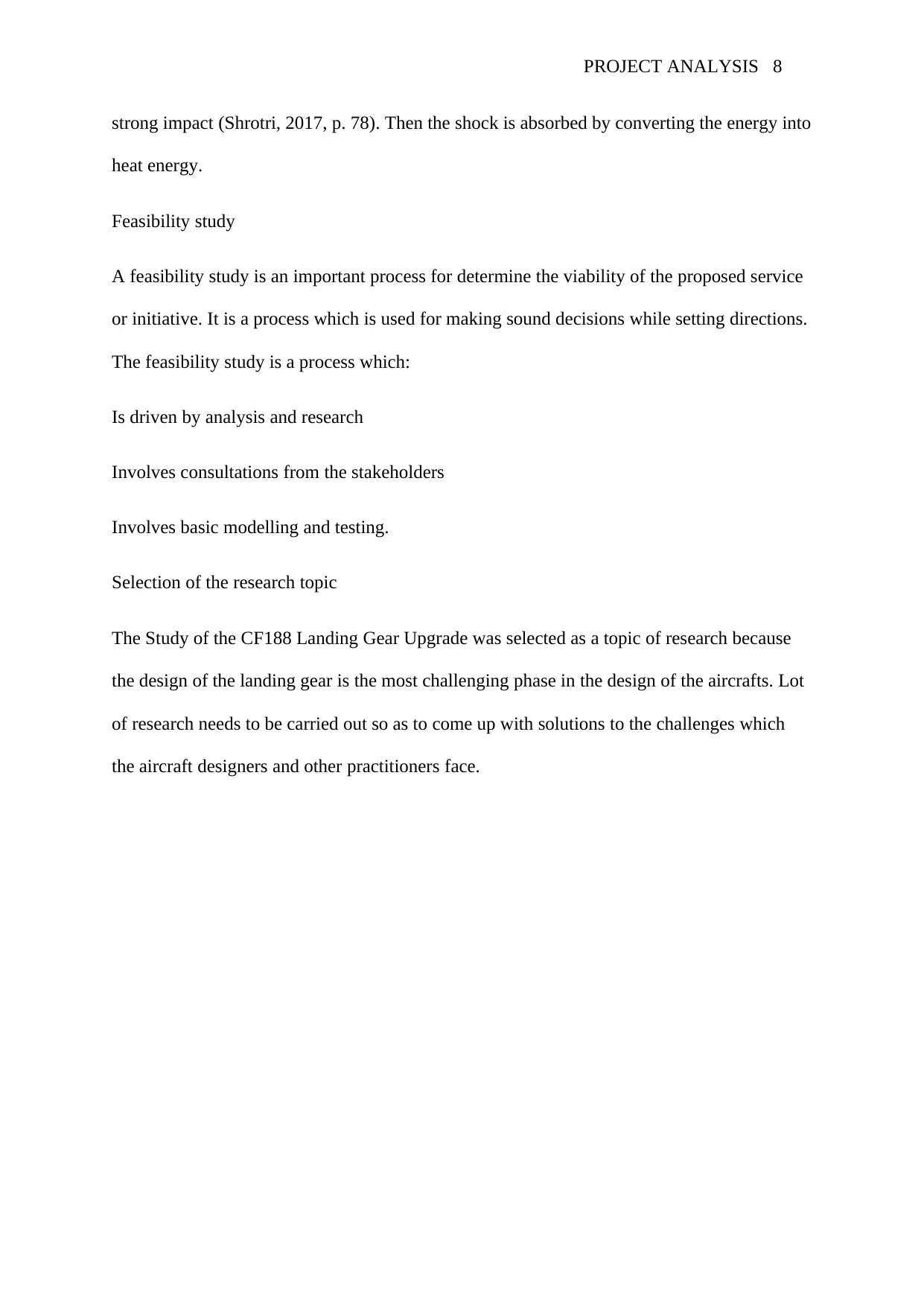
PROJECT ANALYSIS 8
strong impact (Shrotri, 2017, p. 78). Then the shock is absorbed by converting the energy into
heat energy.
Feasibility study
A feasibility study is an important process for determine the viability of the proposed service
or initiative. It is a process which is used for making sound decisions while setting directions.
The feasibility study is a process which:
Is driven by analysis and research
Involves consultations from the stakeholders
Involves basic modelling and testing.
Selection of the research topic
The Study of the CF188 Landing Gear Upgrade was selected as a topic of research because
the design of the landing gear is the most challenging phase in the design of the aircrafts. Lot
of research needs to be carried out so as to come up with solutions to the challenges which
the aircraft designers and other practitioners face.
strong impact (Shrotri, 2017, p. 78). Then the shock is absorbed by converting the energy into
heat energy.
Feasibility study
A feasibility study is an important process for determine the viability of the proposed service
or initiative. It is a process which is used for making sound decisions while setting directions.
The feasibility study is a process which:
Is driven by analysis and research
Involves consultations from the stakeholders
Involves basic modelling and testing.
Selection of the research topic
The Study of the CF188 Landing Gear Upgrade was selected as a topic of research because
the design of the landing gear is the most challenging phase in the design of the aircrafts. Lot
of research needs to be carried out so as to come up with solutions to the challenges which
the aircraft designers and other practitioners face.
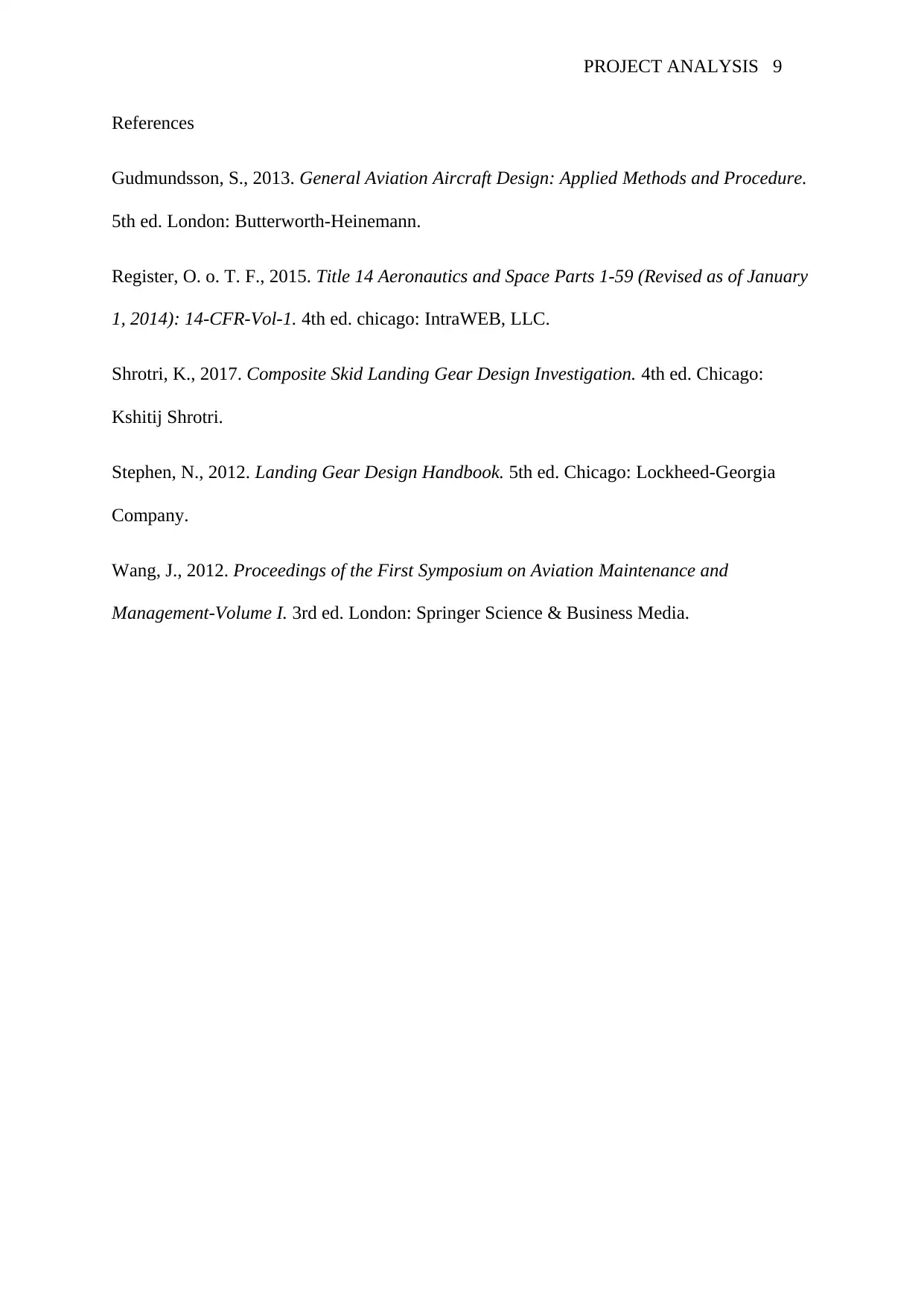
PROJECT ANALYSIS 9
References
Gudmundsson, S., 2013. General Aviation Aircraft Design: Applied Methods and Procedure.
5th ed. London: Butterworth-Heinemann.
Register, O. o. T. F., 2015. Title 14 Aeronautics and Space Parts 1-59 (Revised as of January
1, 2014): 14-CFR-Vol-1. 4th ed. chicago: IntraWEB, LLC.
Shrotri, K., 2017. Composite Skid Landing Gear Design Investigation. 4th ed. Chicago:
Kshitij Shrotri.
Stephen, N., 2012. Landing Gear Design Handbook. 5th ed. Chicago: Lockheed-Georgia
Company.
Wang, J., 2012. Proceedings of the First Symposium on Aviation Maintenance and
Management-Volume I. 3rd ed. London: Springer Science & Business Media.
References
Gudmundsson, S., 2013. General Aviation Aircraft Design: Applied Methods and Procedure.
5th ed. London: Butterworth-Heinemann.
Register, O. o. T. F., 2015. Title 14 Aeronautics and Space Parts 1-59 (Revised as of January
1, 2014): 14-CFR-Vol-1. 4th ed. chicago: IntraWEB, LLC.
Shrotri, K., 2017. Composite Skid Landing Gear Design Investigation. 4th ed. Chicago:
Kshitij Shrotri.
Stephen, N., 2012. Landing Gear Design Handbook. 5th ed. Chicago: Lockheed-Georgia
Company.
Wang, J., 2012. Proceedings of the First Symposium on Aviation Maintenance and
Management-Volume I. 3rd ed. London: Springer Science & Business Media.
⊘ This is a preview!⊘
Do you want full access?
Subscribe today to unlock all pages.

Trusted by 1+ million students worldwide
1 out of 9
Related Documents
Your All-in-One AI-Powered Toolkit for Academic Success.
+13062052269
info@desklib.com
Available 24*7 on WhatsApp / Email
![[object Object]](/_next/static/media/star-bottom.7253800d.svg)
Unlock your academic potential
Copyright © 2020–2025 A2Z Services. All Rights Reserved. Developed and managed by ZUCOL.




